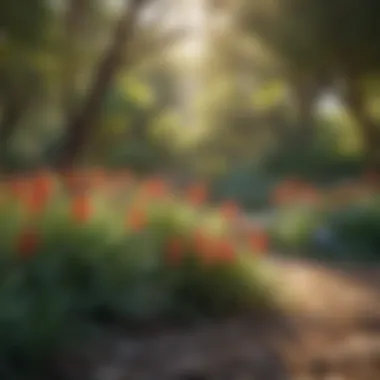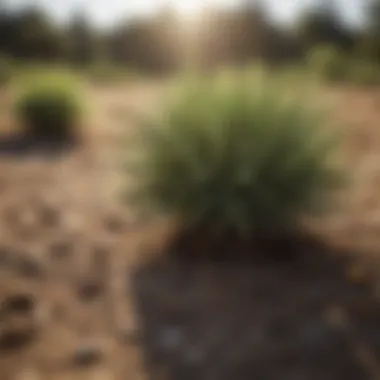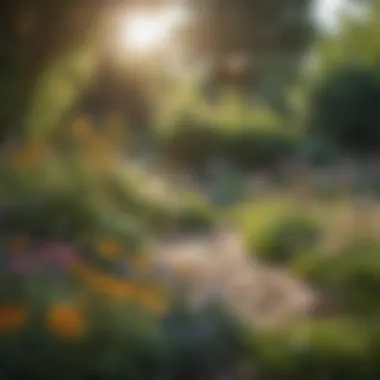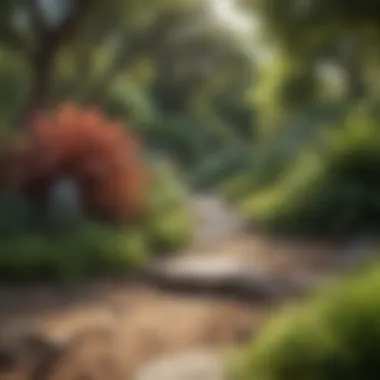Optimal Plants for North Texas Gardening Guide


Intro
Gardening in North Texas presents a unique set of challenges and opportunities, shaped by the region's diverse climate and soil types. Understanding these factors is vital for anyone looking to cultivate a thriving garden. The goal here is to pin down not just what to plant, but why these choices matter. This guide dives into the essentials of selecting optimal vegetation that not only fits the environmental context but also promotes sustainability and biodiversity.
North Texas is characterized by its hot summers and varied rainfall patterns. This makes it essential to focus on drought-resistant species that can withstand periods of dry weather. Moreover, the ecological significance of native flora cannot be understated as they provide habitats and food sources for local wildlife, including bees and birds.
So, whether you're a novice gardener starting with a small patch or an experienced horticulturist looking to expand your garden, this resource aims to equip you with actionable insights. By prioritizing plant species that thrive in North Texas, you ensure a garden that is both beautiful and resilient.
Preamble to North Texas Gardening
Gardening in North Texas presents unique challenges and rewards. Understanding the local environment is a necessity for success. The specific climatic conditions, varied soil types, and diverse wildlife all play a significant role in determining which plants will thrive. This section aims to highlight those elements, giving gardeners the understanding they need to make informed choices.
Understanding the Regional Climate
Temperature ranges and seasons
North Texas is characterized by hot summers and mild winters. The temperature can swing from the high 90s during the summer months to occasional freezes in winter. This broad range creates a growing environment that can be both a blessing and a curse for gardeners. Selecting the right plants that can tolerate such extremes is essential for ensuring a successful garden.
The key characteristic of this climate is its rapid temperature changes, which can stress out non-native plants. An understanding of this allows gardeners to select plants that not only endure but thrive. The sun's strength during summer necessitates a focus on drought-tolerant varieties that are used to such conditions. Conversely, when winter comes, consideration for cold tolerance becomes paramount.
"Gardening is cheaper than therapy and you get tomatoes."
Rainfall patterns
North Texas is known for its unpredictable rainfall patterns, averaging around 30 to 40 inches a year, mostly concentrated in the spring and fall. This can lead to periods of drought followed by heavy downpours. As a result, understanding these patterns is critical in planning a garden.
The key characteristic here is the irregularity of the rain, meaning that gardeners need to adopt methods for conserving moisture, like mulching. This erratic rainfall can be seen as both a challenge and an opportunity, influencing which drought-resistant plants to integrate into designs. Focusing on species that can handle both drought and brief floods is a wise approach.
Wind and humidity factors
Wind velocity in North Texas can often be a challenge. During certain seasons, winds can whip through at considerable speeds, drying out plants quickly. The key characteristic of this factor lies in its impact on transpiration, which can stress plants, especially young ones. Humidity, while typically low, can spike during certain weather systems, influencing plant health in various ways.
Windbreaks such as native trees or shrubs can be effective. They not only reduce wind damage but can also create a favorable micro-climate for more delicate plants. Noticing how these factors interplay provides a pathway to a healthier garden scenario.
Soil Composition and Types
Clay soil characteristics
Clay soil is prevalent across North Texas. It has its unique properties, known for its heavy consistency and poor drainage. This means that while it can hold nutrients well, it also requires careful management to prevent waterlogging.
The key characteristic one should keep in mind is its ability to retain moisture. This can be beneficial during hot, dry spells; however, it’s essential to choose the right plants that can adapt to this. Specific amendments can make clay soil more garden-friendly, improving aeration and drainage.
Sandy soil properties
Sandy soils, while less common, present a different set of challenges. They drain very quickly, which can lead to drought stress if not monitored. The key characteristic of sandy soil is its lack of nutrient retention, which means regular amendments or nutrient additions are necessary.
Plants suited for sandy soil often have deeper root systems, making them resilient against dry spells. Integrating organic matter is also crucial to enhance its structure and improve nutrient availability.
Amendments for soil improvement
Improving soil requires some know-how. Gardeners should consider various amendments such as compost, peat moss, or even specific mulches. These materials can enhance soil structure, drainage, and nutrient availability. The key characteristic to note here is the benefits of organic matter, which helps to create a thriving ecosystem in the soil.
Key Considerations for Plant Selection
Choosing the right plants for any garden is critical, and North Texas presents its own set of challenges and opportunities. Understanding the peculiarities of this region allows gardeners to make informed decisions that lead to a thriving landscape. Key considerations in plant selection revolve around factors such as drought resistance, native versus non-native plants, and the importance of attracting wildlife and pollinators.
When gardeners prioritize these aspects, they enhance not only their gardens but also the broader ecosystem. There’s a sense of responsibility in curating gardens that respect the local environment while bringing beauty to the landscape. This guide lays out those essential considerations that any gardener in North Texas should ponder before digging in.
Drought Resistance
Importance of xeriscaping
Xeriscaping is essentially a water-wise gardening method that's become increasingly crucial in areas where water scarcity exists. For North Texas, this method serves as a powerful tool to combat the effects of prolonged droughts that are often seen in the summer months. By utilizing plants that require minimal irrigation, gardeners not only save on water bills but also contribute to a more sustainable community.


A key characteristic of xeriscaping is its focus on designing landscapes that work with the natural environment. This approach is not just trendy; it's a way of life for many residents in the area. Xeriscaping emphasizes native plants, which are better adapted to local climate conditions and thrive without excessive water.
"A water-efficient garden isn’t just an aesthetic choice; it’s a statement about environmental stewardship."
The unique feature here is the potential for lower maintenance costs over time. Because xeriscaped gardens often utilize perennials and drought-tolerant plants, they require reduced upkeep once established. However, it’s essential to remember that this method may have limitations regarding plant variety and may not provide the same lushness as traditional watering might.
Plants that thrive in dry conditions
When selecting plants that flourish in dry conditions, one must consider both their aesthetic value and adaptability to the harsh elements of North Texas. Certain plants have evolved to withstand arid climates, making them particularly suitable for any gardener’s toolkit. Examples include lavender, agave, and yucca.
What sets these plants apart as a beneficial choice is their ability to retain moisture—thanks to their thick, sometimes waxy leaves that slow down water loss. Additionally, many of these plants bring vibrant colors and unique textures to the garden, making them visually appealing.
A notable advantage of cultivating drought-resistant plants is their remarkable longevity; once they’re established, they flourish with minimal care. While the initial growth phase may require more attention, incorporating these hardy species into your garden layout creates a sense of resilience against the sweltering Texas sun.
Native vs. Non-native Plants
Benefits of native species
Native plants are those that originate from the local region and have adapted to its climate and soil over the years. One compelling aspect of choosing native species is their inherent resilience. Native plants typically require less water, fewer fertilizers, and reduced pest control measures. This plays a significant role in aiding environmentally friendly gardening efforts.
Another key characteristic is their appeal to local wildlife. Species like Black-eyed Susans or the Texas Bluebonnet are not only beautiful in their own right but also serve as essential food sources for local pollinators and other fauna. These plants create a network of life in your garden that contributes to biodiversity.
However, the drawback could be a perceived lack of variety compared to non-native options. While native species offer robust performance, they may not always provide the same range of colors or unusual forms that some gardeners desire.
Potential drawbacks of non-native options
Non-native plants can sometimes create an alluring garden appearance. They might provide vibrant blooms and striking foliage, making them initially appealing to many. Yet, the potential drawbacks merit consideration.
One key issue with non-native species is their lack of adaptation to local pests and diseases. Often, these plants may need frequent pesticides to thrive, which can lead to a cycle of dependence on chemicals that affect surrounding wildlife negatively. Moreover, some non-native plants can escape cultivation and become invasive, threatening local ecosystems.
Thus, while utilizing non-native species can result in a visually stunning garden, it raises significant concerns regarding sustainability and ecological harmony.
Wildlife and Pollinator Support
Importance of attracting pollinators
Attracting pollinators is reaping great benefits for any garden. Pollinators like bees, butterflies, and hummingbirds play a crucial role in fertilizing plants, allowing for healthy growth and reproduction. This enhances the biodiversity of the garden and ensures the overall sustainability of the ecosystem.
Gardens that focus on attracting these vital creatures are often composed of flowering plants that yield nectar and pollen. The unique feature here is the interaction that occurs between the plants and pollinators. Such relationships boost crop production, ensuring the garden isn’t just beautiful but functional as well.
In terms of disadvantages, a garden without consideration for pollinators might struggle, particularly when flowering plants are not included. This absence affects the yields of fruits and vegetables, and the overall health of the entire garden can suffer.
Plants that support local wildlife
Choosing plants that inherently support local wildlife creates a rich tapestry of life within the garden. Many native North Texas plants not only attract pollinators but also provide food and habitat for birds and insects. For instance, planting flowering native perennials or shrubs can lead to a bustling garden teeming with life.
The key characteristic of these plants is their suitability for local fauna; they’re naturally part of the food web and help sustain local wildlife populations.
A unique advantage is the increased variety of life in the garden, which in turn improves pest control and the overall balance in the ecosystem. However, the downside may be a garden that does not conform to traditional landscaping standards, which may not appeal to everyone’s aesthetic preferences.
The Best Plants for North Texas
Choosing the right plants for a garden in North Texas is pivotal for successful gardening. With the region’s unique climate, which swings between scorching summers and mild winters, understanding which flora thrive here makes all the difference. Selecting optimal plants not only beautifies your space but also ensures sustainability and resilience, especially in times of drought.
Flowering Plants
Texas Bluebonnet
The Texas Bluebonnet, or Lupinus texensis, stands as a symbol of the Lone Star State, often painting landscapes in vibrant blue hues come spring. This hardy perennial thrives in a range of soil types, though it's particularly fond of well-drained spots. The key characteristic that sets the Bluebonnet apart is its ability to act as a nitrogen fixer; it enriches the soil, improving its quality for neighboring plants. Not to mention, it's a magnificent sight, attracting bees and butterflies, thus supporting local pollinators.
On the downside, it can be sensitive to overwatering and doesn’t do well in overly rich soils, which can lead it to flop over.
Black-eyed Susan
The Rudbeckia hirta, or Black-eyed Susan, is another darling of North Texas gardens, easily recognizable by its golden petals and dark centers. Besides being stunning, this flowering plant is quite pack-a-punch when it comes to resilience. It thrives in poor soil and can handle drought better than many other colorful options. This makes it a top pick for those looking to brighten their spaces with minimal fuss.


However, beware of its tendency to spread; if left unchecked, it can take over a garden patch. For those who like a bit of maintenance, this can be an opportunity to keep your garden looking tidy.
Mexican Hat
The Mexican Hat, or Ratibida columnifera, adds a unique flair to gardens with its distinctive sombrero-shaped blooms. This native wildflower not only tolerates the hot Texas sun but also attracts a variety of pollinators. Known for its tolerance of dry conditions, it's a significant choice for gardeners wishing to practice xeriscaping. The vibrant colors also bring a lively atmosphere to flower beds.
In contrast, its height can be a drawback in tighter gardening plots, where it may overshadow shorter plants, complicating your garden's overall look.
Trees and Shrubs
Live Oak
The Live Oak (Quercus virginiana) is a stalwart among trees in North Texas, renowned for its strength and vast canopy. One of its significant advantages is that it's highly drought-resistant once established, making it perfect for the region’s water-saving demands. This tree can grow to impressive heights and provide ample shade for both buildings and gardens.
However, its slow growth rate can be a bummer for those looking for quick results in landscaping. Patience is a must with this beauty.
Crepe Myrtle
The Crepe Myrtle is a showstopper in the summertime, offering blooms that come in various colors. Its primary strength lies in its ability to flourish in heat and humidity, requiring minimal maintenance. Not only does it provide flowers, but its smooth bark and vibrant foliage also ensure year-round beauty.
Nonetheless, if not properly pruned, it can develop a rather scraggly appearance, leaving some gardeners feeling less than thrilled about its aesthetics.
Texas Sage
For those looking for a drought-tolerant shrub, the Texas Sage is hard to beat. Known for its silvery leaves and purple flowers, it brings an appealing look to any garden. It's also incredibly resilient, thriving in poor soils and requiring little water. Beyond beauty, it attracts butterflies and other pollinators, supporting local ecology.
On the flip side, being a semi-tropical plant, it may struggle through colder winters if not adequately protected.
Grasses and Ground Covers
Bermudagrass
Bermudagrass dominates as a go-to turf for many Texans. It thrives in full sun and is particularly hardy during the hot summer months. This grass type is loved for its quick recovery after drought or heavy traffic, making it a resilient choice for lawns and fields alike.
However, keep an eye on its invasive nature; it can spread rapidly if not contained properly through edging or regular mowing.
Buffalograss
Buffalograss, Buchloe dactyloides, stands out for its low water needs and ability to thrive in poor soils. This native grass can provide a lush lawn without the high maintenance demands seen in other varieties. It’s an excellent addition for those keen on an eco-friendly approach.
One drawback is its preference for sunny regions, which means shadier yards might not benefit as much.
Dallas Clover
Dallas Clover, or Trifolium repens, is remarkable for ground cover. It not only suppresses weeds but also adds nitrogen to the soil, making it a beneficial addition to any garden. This particular clover thrives in well-drained soils and can handle some drought, making it practical for lower-maintenance gardening.
However, its growth habit may lead to it taking over more than some gardeners would prefer, requiring regular maintenance to keep it in check.
Vegetables and Herbs
Tomatoes
Tomatoes are arguably one of the most rewarding plants to cultivate in North Texas gardens. They thrive in warmth and can produce fruit well into the fall if cared for correctly. Rich in vitamins and flavors, homegrown tomatoes can enhance any meal.
Yet, they can be susceptible to pests like aphids and spider mites, requiring vigilant monitoring.
Peppers
Peppers flourish in hot Texas summers and vary in heat, offering something for everyone. Whether sweet or spicy, they’re a delight both in the garden and kitchen. They handle dry spells well, making them a low-maintenance option.
Their drawback? Pepper plants can be sensitive to frost, so gardeners need to be mindful of the late-fall temperatures.
Mint


Mint is a popular choice for herb gardens, known for its refreshing aroma and flavor. It grows vigorously and provides an appealing touch to beverages and dishes. As a bonus, mint plants are often favored by pollinators.
However, it can become invasive quickly. Gardeners might want to consider using containers to keep it contained.
Good plant choices combined with proper care can lead to flourishing gardens, even in challenging environments like North Texas.
Practical Gardening Tips
When it comes to gardening in North Texas, practical gardening tips can make all the difference whether you're seasoned or a beginner. These strategies and methods not only improve plant health but also your overall experience in the garden. Simple adjustments to how you plant and care for your garden can really enhance the success of your gardening endeavors. Here, we explore essential planting techniques, maintenance strategies, and sustainable garden practices to help your green spaces thrive.
Planting Techniques
Best practices for planting
When you consider best practices for planting, it’s about ensuring that each plant gets the best start possible. This involves several important elements. For instance, preparing the soil properly is key. Amending soil with organic matter enhances drainage and nutrient availability, creating a hospitable environment for the roots. Using native plants is also a significant aspect here; they’re already adapted to the local conditions. Plus, spacing plants correctly allows for air circulation, reducing the risk of diseases. One unique feature of this practice is planting at the right depth. If plant roots are buried too deep or not deep enough, they struggle to establish.
With these practices, you’ll find a more robust yield and vibrant blooms, contributing positively to both your garden's aesthetics and health.
Timing for planting seasons
Understanding the timing for planting seasons is crucial to ensuring your garden flourishes. In North Texas, knowing when to plant different species can empower your garden to withstand both heat and cold. For instance, the ideal time for planting warm-season veggies is in late spring, while many flowering plants thrive when planted in early spring.
This timing is not just about climate; it’s also about the natural growth cycles of plants. Following lunar phases or local weather patterns can determine the best time to sow seeds or transplant seedlings. One major advantage here is avoiding frost, which can devastate new plants. However, be aware that mismanagement of timing can lead to stunted growth or even plant death. Monitoring local climate trends ensures you’re planting during the optimal window for success.
Maintenance Strategies
Watering schedules
An effective watering schedule is paramount. Overwatering can lead to root rot, while underwatering can stress plants, making them susceptible to disease and pests. It’s all about finding a balance. In North Texas, the heat can quickly dry out the soil, so this region may require more frequent watering during summers but less in the cooler months.
Adopting methods like deep watering encourages roots to grow deeper, creating sturdier plants. A unique feature of this approach is integrating smart irrigation systems that adapt to rainfall and humidity, which also conserves water. That’s not just good for the environment; it's also an economic win. The downside? Establishing a correct schedule requires diligence and observation to avoid guesswork.
Pest management approaches
Managing pests effectively is a critical part of maintaining your North Texas garden. A thriving garden attracts insects, some of which are beneficial while others can quickly become problematic. Utilizing integrated pest management (IPM) strategies—like encouraging beneficial predators and using organic pesticides—can minimize the impact of harmful species without causing undue harm to the ecosystem.
The key characteristic of these approaches is that they rely on observation and careful action rather than blanket treatments. This thoughtful strategy allows for targeted action against pests, reducing the chemical footprint. However, getting a handle on pest populations can take time and patience as you learn which critters are friends and which are foes.
Creating a Sustainable Garden
Permaculture principles
Permaculture is a holistic approach to gardening that emphasizes designing your garden with nature in mind. This means observing how ecosystems function and mimicking those relationships within your own garden. For North Texas, incorporating permaculture principles can lead to a more resilient and lower-maintenance garden.
One of the major benefits is biodiversity. By creating various habitats within your garden, you attract a range of beneficial creatures that can naturally manage pests and pollition. However, it takes careful planning to ensure your garden is functioning as a cohesive unit. Ignoring nutrient cycles or plant relationships can limit the advantages of this approach.
Composting practices
Composting is a method that can greatly improve soil health. By recycling kitchen scraps and garden waste, you create nutrient-rich compost that supports plant growth. This practice not only reduces waste but also enhances the soil’s structure and fertility.
The unique feature of composting is its sustainability. Rather than relying solely on store-bought fertilizers, you maintain a self-sufficient system that nourishes your garden. While it requires an initial investment of time to set up and manage, the long-term benefits are undeniable. Balancing browns and greens in your compost can be a bit tricky, but ultimately, you will have a garden that's not just sustainable but abundant.
The End
Gardening in North Texas presents unique challenges and opportunities, and the choices made in plant selection can significantly impact a garden's success. Understanding the importance of this topic is crucial for anyone looking to cultivate a thriving garden in this distinct climate. A well-considered selection of plants not only influences the sustainability of the garden but also promotes the health of local wildlife and ecosystems.
Reflecting on Plant Selection
Summary of key points
The summary of key points is a pivotal aspect of the article, offering a concise overview of essential factors when choosing plants for North Texas. Highlighting the diversity of climate-appropriate and resilient species ensures that gardeners can make informed decisions. The emphasis on drought-resistant flora, especially, stands out; these plants conserve water and thrive in the region's sporadic rainfall. This characteristic makes them a beneficial choice for managing local environmental challenges.
Moreover, native plants showcase unique adaptations allowing them to flourish in North Texas. They not only beautify gardens but also play a significant role in supporting local pollinators, enhancing biodiversity. The unique feature of leveraging native species lies in their minimal requirements for maintenance and water, creating a win-win situation for both gardeners and the environment.
Final thoughts on cultivating in North Texas
Final thoughts on cultivating in North Texas encapsulate a more significant narrative about resilience and adaptability in gardening. Emphasizing a thoughtful approach to plant selection reinforces the idea of long-term sustainability. By acknowledging the climatic vagaries and soil variances, gardeners can make choices that reflect both personal aesthetics and ecological responsibility.
The focus on creating a garden that resonates with the local ecosystem is increasingly popular, as many individuals are now more mindful of their environmental footprint. A unique aspect of cultivating in this region is the possibility of engaging not just with plants, but with the larger community of local wildlife. The advantages of fostering such an environment include reduced maintenance needs and a richly diverse habitat that supports pollinators.
In summary, the reflections on plant selection and the overall cultivation practices in North Texas serve as a reminder that gardening is more than just planting. It's about understanding our environment, making wise choices, and contributing positively to the ecosystem. By adopting these principles, gardeners can create spaces that are not only visually appealing but are also thriving hubs of life.







